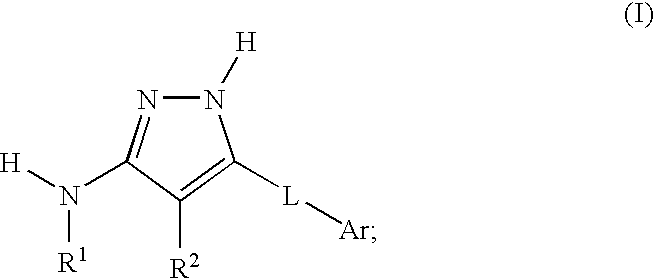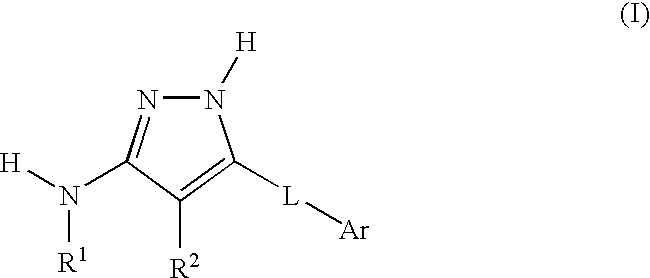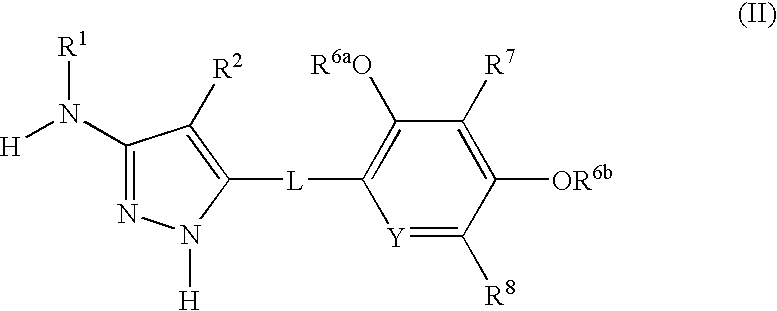Aminopyrazole compounds
- Summary
- Abstract
- Description
- Claims
- Application Information
AI Technical Summary
Benefits of technology
Problems solved by technology
Method used
Image
Examples
example 1
Synthesis of Compound 1
A. Preparation of Intermediate 1a: N-(3-Cyanophenyl)-3-(2′,4′-dimethoxy-1,1′-biphenyl-4-yl)-3-oxopropanamide
To a solution of methyl 3-(2′,4′-dimethoxy-1,1′-biphenyl-4-yl)-3-oxopropanoate(499 mg, 1.59 mmol) in xylenes (3 mL) was added a solution of 3-aminobenzonitrile(206 mg, 1.75 mmol) in xylenes (3 mL). The mixture was heated under nitrogen in a 150° C. oil bath for 6 hrs, after which time TLC indicated completion of the reaction. The amide product was purified by trituration using ethyl acetate:hexanes 1:5. The insoluble material was collected by filtration and washed several times with ethyl acetate:hexanes 1:5 followed by ethyl acetate:hexanes 1:3. This material was then vacuum pump dried overnight yielding the title compound as a yellow powder (262 mg, 41%). 1H NMR (DMSO-d6) δ: 3.78 (3H, s), 3.81 (3H, s), 4.19 (2H, s) 6.64 (1H, m), 6.60 (1H, t, J=2.08 Hz), 7.29 (1H, m), 7.55 (2H, m), 7.64 (2H, d, J=8.47), 7.78 (1H, m), 8.01 (1H, d, J=8.29 Hz), 8.09 (...
example 2
Synthesis of Compound 2
A. Preparation of Intermediate 2a: N-(4-cyanophenyl)-3-(2′,4′-dimethoxy-1,1 ′-biphenyl-4-yl)-3-oxopropanamide
Compound 2a was synthesized using the same procedure as that of compound 1a. 1H NMR (DMSO-d6) δ: 3.78 (3H, s), 3.81 (3H, s), 4.21 (2H, s), 6.65 (1H, d, J=8.59), 6.69 (1H, m), 7.31 (1H, d, J=8.33), 7.64 (2H, d, J=8.59), 7.78 (5H, m), 8.00 (2H, d, J=8.34), 10.65 (1H, s).
B. Preparation of Intermediate 2b: 4-{[3-(2′,4′-dimethoxy-1,1′-biphenyl-4-yl)-1H-pyrazol-5-yl]amino}benzonitrile
Compound 2b was synthesized using the same procedure as that of compound 1b. 1H NMR (CDCl3) δ: 3.81 (3H, s), 3.87 (3H, s), 6.58 (2H, m), 6.90 (1H, m), 7.21 (1H, m), 7.26 (1H, m), 7.47 (2H, bm), 7.62 (3H, bm), 7.71 (1H, d, J=8.29), 7.88 (1H, m)
C. Preparation of
Compound 2 was synthesized using the procedures of Figures I and II (see general preparation of Compound 3). 1H NMR (Acetone-d6) δ: 6.38 (1H, s), 6.46 (1H, dd, J=8.33 Hz), 6.54 (1H, m), 7.20 (1H, d, J=8.34 Hz)...
example 3
Preparation of Compound 3
A. Preparation of Intermediate 3a: Cyclopropyl-{3-[3-(2′,4′-dimethoxy-biphenyl-4-yl)-3-oxo-propionylamino]-benzyl}-carbamic acid tert-butyl ester
Compound 3a was synthesized using the same procedure as that of compound 1a. 1H NMR (CDCl3) δ 9.42 (b, 1H), 8.05 (d, 2H), 7.64 (d, 2H), 7.51 (m, 2H), 7.26 (m, 2H), 6.99 (d, 1H), 6.57 (m, 2H), 4.42 (s, 2H), 4 12 (s, 2H), 3.86 (s, 3H), 3.81 (s, 3H), 2,49 (b, 1H), 1.47 (s, 9H), 0.71 (m, 4H). MS (ESI) M++1, 545.
B. Preparation of Intermediate 3b: 4′-[5-(N-Boc-3-Cyclopropylaminomethyl-phenylamino)-2H-pyrazol-3-yl]-2,4-dimethoxy biphenyl
Compound 3b was synthesized using the same procedure as that of compound 1b. 1H NMR (CDCl3) δ 7.63 (d, 2H), 7.59 (d, 2H), 7.27 (s, 1H), 7.20 (t, 1H), 7.07 (b, 2H)), 6.76 (d, 1H), 6.57 (d, 2H), 6.34 (s, 1H), 4.39 (s, 2H), 3.85 (s, 3H), 3.81 (s, 3H), 2.50 (b, 1H), 1.43 (s, 9H), 0.71 (m, 4H). MS (ESI) M++1, 541.
C. Preparation of
To a solution of dimethoxy biphenyl 3b (247 mg, 0.4...
PUM
| Property | Measurement | Unit |
|---|---|---|
| Composition | aaaaa | aaaaa |
| Structure | aaaaa | aaaaa |
| Pharmaceutically acceptable | aaaaa | aaaaa |
Abstract
Description
Claims
Application Information
 Login to View More
Login to View More - R&D
- Intellectual Property
- Life Sciences
- Materials
- Tech Scout
- Unparalleled Data Quality
- Higher Quality Content
- 60% Fewer Hallucinations
Browse by: Latest US Patents, China's latest patents, Technical Efficacy Thesaurus, Application Domain, Technology Topic, Popular Technical Reports.
© 2025 PatSnap. All rights reserved.Legal|Privacy policy|Modern Slavery Act Transparency Statement|Sitemap|About US| Contact US: help@patsnap.com



